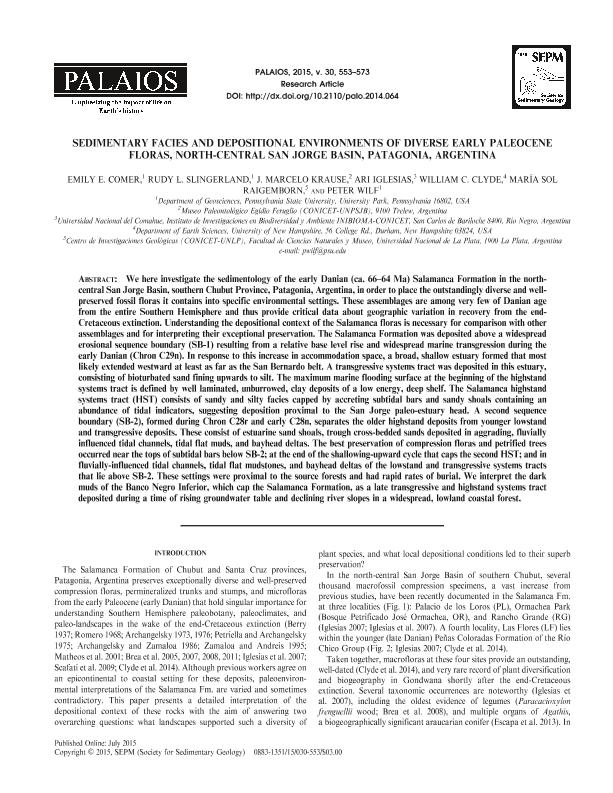Mostrar el registro sencillo del ítem
dc.contributor.author
Comer, Emily E.
dc.contributor.author
Slingerland, Rudy L.
dc.contributor.author
Krause, Javier Marcelo

dc.contributor.author
Iglesias, Ari

dc.contributor.author
Clyde, William
dc.contributor.author
Raigemborn, María Sol

dc.contributor.author
Wilf, Peter
dc.date.available
2018-04-11T17:56:33Z
dc.date.issued
2015-07
dc.identifier.citation
Comer, Emily E.; Slingerland, Rudy L.; Krause, Javier Marcelo; Iglesias, Ari; Clyde, William; et al.; Sedimentary facies and depositional environments of diverse early paleocene floras, north-central San Jorge basin, Patagonia, Argentina; Society for Sedimentary Geology; Palaios; 30; 7; 7-2015; 553-573
dc.identifier.issn
0883-1351
dc.identifier.uri
http://hdl.handle.net/11336/41736
dc.description.abstract
We here investigate the sedimentology of the early Danian (ca. 66-64 Ma) Salamanca Fm. in the north-central San Jorge Basin, southern Chubut Province, Patagonia, Argentina, in order to place the outstandingly diverse and well-preserved fossil floras it contains into specific environmental settings. These assemblages are among very few of Danian age from the entire Southern Hemisphere and thus provide critical data about geographic variation in recovery from the end-Cretaceous extinction. Understanding the depositional context of the Salamanca floras is necessary for comparison with other assemblages and for interpreting their exceptional preservation. The Salamanca Fm. was deposited above a widespread erosional sequence boundary (SB-1) resulting from a relative base level rise and widespread marine transgression during the early Danian (Chron C29n). In response to this increase in accommodation space, a broad, shallow estuary formed that most likely extended westward at least as far as the San Bernardo belt. A transgressive systems tract was deposited in this estuary, consisting of bioturbated sand fining upwards to silt. The maximum marine flooding surface at the beginning of the highstand systems tract is defined by well laminated,unburrowed, clay deposits of a low energy, deep shelf. The Salamanca highstand systems tract (HST) consists of sandy and silty facies capped by accreting subtidal bars and sandy shoals containing an abundance of tidal indicators, suggesting deposition proximal to the San Jorge paleo-estuary head. A second sequence boundary (SB-2), formed during Chron C28r and early C28n, separates the older highstand deposits from younger lowstand and transgressive deposits. These consist of estuarine sand shoals, trough cross-bedded sands deposited in aggrading, fluvially-influenced tidal channels, tidal flat muds, and bayhead deltas. The best preservation of compression floras and petrified trees occurred near the tops of subtidal bars below SB-2; at the end of the shallowing-upward cycle that caps the second HST; and in fluvially-influenced tidal channels, tidal flat mudstones, and bayhead deltas of the lowstand and transgressive systems 48 tracts that lie above SB-2. These settings were proximal to the source forests and had rapid rates of burial. We interpret the dark muds of the Banco Negro Inferior, which cap the Salamanca Formation, as a late transgressive and highstand systems tract deposited during a time of rising groundwater table and declining river slopes in a widespread, lowland coastal forest.
dc.format
application/pdf
dc.language.iso
eng
dc.publisher
Society for Sedimentary Geology

dc.rights
info:eu-repo/semantics/openAccess
dc.rights.uri
https://creativecommons.org/licenses/by-nc-sa/2.5/ar/
dc.subject
Danian
dc.subject
Estuary
dc.subject
Facies
dc.subject
Paleobotany
dc.subject
Paleocene
dc.subject
Salamanca Formation
dc.subject
Sedimentary Environments
dc.subject.classification
Meteorología y Ciencias Atmosféricas

dc.subject.classification
Ciencias de la Tierra y relacionadas con el Medio Ambiente

dc.subject.classification
CIENCIAS NATURALES Y EXACTAS

dc.title
Sedimentary facies and depositional environments of diverse early paleocene floras, north-central San Jorge basin, Patagonia, Argentina
dc.type
info:eu-repo/semantics/article
dc.type
info:ar-repo/semantics/artículo
dc.type
info:eu-repo/semantics/publishedVersion
dc.date.updated
2018-04-11T16:00:31Z
dc.journal.volume
30
dc.journal.number
7
dc.journal.pagination
553-573
dc.journal.pais
Estados Unidos

dc.journal.ciudad
Lawrence
dc.description.fil
Fil: Comer, Emily E.. State University of Pennsylvania; Estados Unidos
dc.description.fil
Fil: Slingerland, Rudy L.. State University of Pennsylvania; Estados Unidos
dc.description.fil
Fil: Krause, Javier Marcelo. Museo Paleontológico Egidio Feruglio; Argentina. Consejo Nacional de Investigaciones Científicas y Técnicas; Argentina
dc.description.fil
Fil: Iglesias, Ari. Consejo Nacional de Investigaciones Científicas y Técnicas. Centro Científico Tecnológico Conicet - Patagonia Norte. Instituto de Investigaciones en Biodiversidad y Medioambiente. Universidad Nacional del Comahue. Centro Regional Universidad Bariloche. Instituto de Investigaciones en Biodiversidad y Medioambiente; Argentina
dc.description.fil
Fil: Clyde, William. University of New Hampshire; Estados Unidos
dc.description.fil
Fil: Raigemborn, María Sol. Consejo Nacional de Investigaciones Científicas y Técnicas. Centro Científico Tecnológico Conicet - La Plata. Centro de Investigaciones Geológicas. Universidad Nacional de La Plata. Facultad de Ciencias Naturales y Museo. Centro de Investigaciones Geológicas; Argentina
dc.description.fil
Fil: Wilf, Peter. State University of Pennsylvania; Estados Unidos
dc.journal.title
Palaios

dc.relation.alternativeid
info:eu-repo/semantics/altIdentifier/doi/http://dx.doi.org/10.2110/palo.2014.064
dc.relation.alternativeid
info:eu-repo/semantics/altIdentifier/url/https://pubs.geoscienceworld.org/sepm/palaios/article/30/7/553/331363/SEDIMENTARY-FACIES-AND-DEPOSITIONAL-ENVIRONMENTS
Archivos asociados
